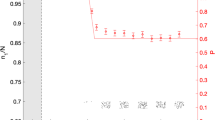Abstract
The divergence of quantum and classical descriptions of particle motion is clearly apparent in quantum tunnelling1,2 between two regions of classically stable motion. An archetype of such non-classical motion is tunnelling through an energy barrier. In the 1980s, a new process, ‘dynamical’ tunnelling1,2,3, was predicted, involving no potential energy barrier; however, a constant of the motion (other than energy) still forbids classically the quantum-allowed motion. This process should occur, for example, in periodically driven, nonlinear hamiltonian systems with one degree of freedom4,5,6. Such systems may be chaotic, consisting of regions in phase space of stable, regular motion embedded in a sea of chaos. Previous studies predicted4 dynamical tunnelling between these stable regions. Here we observe dynamical tunnelling of ultracold atoms from a Bose–Einstein condensate in an amplitude-modulated optical standing wave. Atoms coherently tunnel back and forth between their initial state of oscillatory motion (corresponding to an island of regular motion) and the state oscillating 180° out of phase with the initial state.
This is a preview of subscription content, access via your institution
Access options
Subscribe to this journal
Receive 51 print issues and online access
$199.00 per year
only $3.90 per issue
Buy this article
- Purchase on Springer Link
- Instant access to full article PDF
Prices may be subject to local taxes which are calculated during checkout





Similar content being viewed by others
References
Tomsovic, S. Tunneling and chaos. Physica Scripta T 90, 162–165 (2001).
Caldeira, A. O. & Leggett, A. J. Quantum tunneling in a dissipative system. Ann. Phys. 149, 374–456 (1983).
Davis, M. J. & Heller, E. J. Quantum dynamical tunneling in bound states. J. Chem Phys. 75, 246–254 (1981).
Dyrting, S., Milburn, G. J. & Holmes, C. A. Nonlinear quantum dynamics at a classical second order resonance. Phys. Rev. E 48, 969–978 (1993).
Haake, F., Kus, M. & Scharf, R. Classical and quantum chaos for a kicked top. Z. Phys. B 65, 381–395 (1987).
Sanders, B. C. & Milburn, G. J. The effect of measurement on the quantum features of a chaotic system. Z. Phys. B 77, 497–510 (1989).
Habib, S., Shizume, K. & Zurek, W. H. Decoherence, chaos, and the correspondence principle. Phys. Rev. Lett. 80, 4361–4365 (1998).
Graham, R., Schlautmann, M. & Zoller, P. Dynamical localization of atomic-beam deflection by a modulated standing light wave. Phys. Rev. A 45, R19–R22 (1992).
Moore, F. L., Robinson, J. C., Bharucha, C. F., Sundaram, B. & Raizen, M. G. Atom optics realization of the quantum δ-kicked rotor. Phys. Rev. Lett. 75, 4598–4601 (1995).
Hensinger, W. K., Truscott, A. G., Upcroft, B., Heckenberg, N. R. & Rubinsztein-Dunlop, H. Atoms in an amplitude-modulated standing wave–dynamics and pathways to quantum chaos. J. Opt. B 2, 659–667 (2000).
Hensinger, W. K. et al. Experimental study of the quantum driven pendulum and its classical analog in atom optics. Phys. Rev. A (in the press).
Arnold, V. I. Mathematical Methods of Classical Mechanics (Springer, New York, 1979).
Kozuma, M. et al. Coherent splitting of Bose-Einstein condensed atoms with optically induced Bragg diffraction. Phys. Rev. Lett. 82, 871–875 (1999).
Steck, D. A., Oskay, W. H. & Raizen, M. G. Observation of chaos-assisted tunneling between islands of stability. Science (in the press).
Acknowledgements
We thank C. Holmes for discussions. The NIST group was supported by the ONR, NASA and ARDA, and the University of Queensland group was supported by the ARC. A.B. was partially supported by DGA (France), and H. H. was partially supported by the A. v. Humboldt Foundation. W.K.H. and B.U. thank NIST for hospitality during the experiments.
Author information
Authors and Affiliations
Corresponding author
Rights and permissions
About this article
Cite this article
Hensinger, W., Häffner, H., Browaeys, A. et al. Dynamical tunnelling of ultracold atoms. Nature 412, 52–55 (2001). https://doi.org/10.1038/35083510
Received:
Accepted:
Issue Date:
DOI: https://doi.org/10.1038/35083510
This article is cited by
-
Observation of a non-equilibrium steady state of cold atoms in a moving optical lattice
Communications Physics (2018)
-
Chaos-Assisted Quantum Tunneling and Delocalization Caused by Resonance or Near-Resonance
International Journal of Theoretical Physics (2018)
-
Controlling the quantum rotational dynamics of a driven planar rotor by rebuilding barriers in the classical phase space
Journal of Chemical Sciences (2017)
-
Nonlinear resonance-assisted tunneling induced by microcavity deformation
Scientific Reports (2015)
-
Aharonov–Bohm effect in the tunnelling of a quantum rotor in a linear Paul trap
Nature Communications (2014)
Comments
By submitting a comment you agree to abide by our Terms and Community Guidelines. If you find something abusive or that does not comply with our terms or guidelines please flag it as inappropriate.



